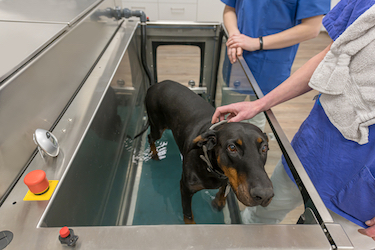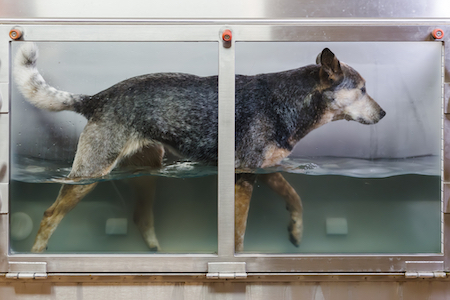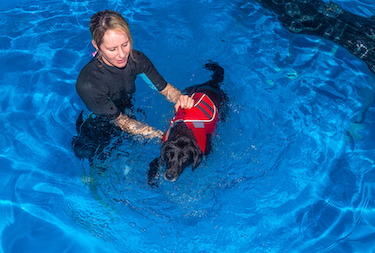Pet Insurance Review > Pet Wellness Guides > Top Alternative Treatments for Dogs: Hydrotherapy
Top Alternative Treatments for Dogs: Hydrotherapy
Posted: 11/06/2023 | BY: Erin Cain | Categories: Uncategorized
Hydrotherapy is a type of hydro-medical rehabilitation for dogs. This treatment effectively treats mobility and neurological problems and relieves pain caused by arthritis or other conditions. It can also help rehabilitate injuries involving the central nervous system and peripheral nerves, such as spinal cord injury, stroke, or traumatic brain injury. Hydrotherapy has proven to be an invaluable tool for helping dogs recover after surgery and injury.
Some people are hesitant about hydrotherapy because they believe it will not work on their dog’s condition due to weight restrictions or age. However, dog hydrotherapy can be customized to meet your pet’s needs no matter what diagnosis! Here’s what you need to know about a top medical treatment for dogs: hydrotherapy.

What is hydrotherapy?
Dog hydrotherapy is a therapy that uses water to help rehabilitate injuries and relieve pain. Hydrotherapists use hydrostatic pressure, whirlpools or baths, and heat treatments to improve the quality of life in dogs with chronic and degenerative conditions. For example, dogs with torn ACLs, hip dysplasia, elbow dysplasia, degenerative joint disease, osteoarthritis, or those paralyzed or lost limbs can benefit from this therapy.
Hydrotherapy uses natural buoyancy, viscosity, pressure, and water resistance to help a dog move injured joints in need of physical rehabilitation. This treatment works through weightless physical therapy that removes any added pressure from gravity. The buoyancy in water reduces the stress on your dog’s joints as she tries to recover from arthritis. This type of therapy can also be beneficial because it is an anti-inflammatory, which helps reduce swelling in our body tissues.

How does hydrotherapy work?
Aquatic therapy is an incredible way to help your dog work through her painful joints and limbs. By altering the water level, they can swim weightlessly in a pool or bathtub without putting any stress on themselves. Hydrotherapy also provides zero-impact exercise for dogs with limited mobility and paralyzed dogs. It makes them use muscles that are not usually used when walking around normally. For older dogs and senior dogs, this exercise puts the spring back in their step.
Controlled swimming is an excellent way to strengthen your dog’s muscles without the stress associated with land-based exercise. The water allows your pup to enjoy a workout in complete safety while limiting muscle tension and potential pain because it’s easier on joints.
The water reduces the stress placed on your dog’s limbs and joints, allowing them to enjoy a fun exercise that also speeds their recovery from injury. Injured dogs need a warm bath to reduce inflammation and speed up their recovery. In contrast, colder water can be perfect for working animals who have been physically active during their workout.

What are the different types of hydrotherapy?
Hydrotherapy is a safe way for your injured dog to stay healthy and active. There are three primary types of dog hydrotherapy, each with its own set of benefits that will suit the individual needs of every pup. Consult your veterinarian for a referral to a certified canine rehabilitation practitioner who can determine which of these types of hydrotherapy would work best for your dog.
Dog pool
Dog pools are an excellent means of hydrotherapy. They provide resistance enough to help with joint pain and range of motion for dogs with injuries or arthritis. Water therapy typically focuses on rehabilitation of the chest muscles, elbows, shoulders, and limbs.
The therapist or vet will help determine the size and depth of the therapy pool, as well as any special equipment your pup requires. Most dogs wear a life vest if they don’t enjoy being in the water. For safety, some therapists require all dogs to wear a swim vest, regardless of their comfortability in the water.
Every pup patient will have the assistance of a therapist by their side at all times to monitor movement in the water. No dogs are allowed to swim on their own without the guidance and supervision of the therapist.
Underwater treadmills
An underwater treadmill is an excellent tool for dogs suffering from joint issues or arthritis. By varying the water level, the therapist can control how much weight a dog puts on their limbs. They allow the dog to start with a lower-intensity exercise before gradually increasing the pressure as the dog heals and becomes stronger.
The underwater treadmill is a safe and comfortable way for your dog to exercise. The big glass or watertight plastic container allows room enough so that they can walk around freely. Once the door is shut, the water fills up the space to a level near or right above the dog’s legs.
As the treadmill starts to move slowly, your dog will begin their exercise. The water provides enough resistance to strengthen joint muscles while taking away some of that stress from gravity, making this low-impact activity perfect for rehabilitation.
Whirlpool therapy
Think of it as a spa day for your pup! This type of water therapy is used for dogs who have just undergone major surgeries, and it provides a lot of relief in terms of pain. Dog whirlpools can be compared to an outdoor Jacuzzi but made explicitly with an injured dog’s needs in mind. The therapist will lower your dog into the pool with a harness to treat your pup’s injury. The water level will go no higher than the location of your dog’s injuries or discomfort.
The whirlpool jets provide a refreshing and relaxing massage for your dog. The warm water creates gentle pressure against injured joints, relieving the pain of sore muscles as it moves against the dog’s body.

What are the benefits of hydrotherapy for dogs?
Aside from the benefits of relieving pain and rehabilitating joints, there are other bonuses for hydrotherapy for dogs, including:
- improved blood circulation
- strengthen muscles
- relief from stiffness, swelling, and pain
- faster recovery from injuries
- prevention of muscle spasms
- promotion of tissue healing
- increased range of motion
- gait modification
- cardiovascular fitness
- improved coordination and balance
- reduced inflammation
- increased endurance
- injury prevention
A critical but often overlooked benefit of hydrotherapy for dogs is the improvement of mental and emotional health. Like people, injured or aging dogs can become depressed and anxious when they can’t perform daily activities without pain. Long-term hydrotherapy for dogs not only makes their bodies stronger and relieves pain, but it helps them feel better and happier with their lives.
What medical conditions does hydrotherapy help treat?
Hydrotherapy for dogs can improve a range of canine medical issues and concerns. The most common conditions positively affected by this therapy for dogs are:
- osteoarthritis
- joint swelling
- hip or elbow dysplasia
- diabetes
- Cushing’s disease
- paralysis
- neurological conditions
- obesity
- postoperative recovery
Aquatic therapy is a powerful, healing treatment that can help dogs with various ailments. However, this therapy is not suitable for all breeds of dogs, and some injuries do not respond well to the aquatic exercises. Speak to your vet before starting any rehab program, and they will guide you through what type would best fit your dog’s needs.

How much does canine hydrotherapy cost?
Depending on what kind of hydrotherapy you want for your dog, the prices for this specialized treatment can vary. Your location and the duration of each session also factor into the cost of a hydrotherapy session.
Pool therapy typically ranges between $30 – $50 per 30-minute hydrotherapy session. Underwater treadmill therapy is most costly, with some therapists charging between $110 – $150 per visit. Shop around for a certified and trustworthy therapist, or ask your veterinarian for a recommendation on reasonably priced hydrotherapy in your area.
Does pet insurance cover hydrotherapy for dogs?
Hydrotherapy can give a dog a new “leash” on life, but its costs add up over time. Does pet insurance cover hydrotherapy treatments? The answer is yes! Pet insurance policies cover complementary, alternative, and holistic treatments such as hydrotherapy provided that the therapy is recommended by your veterinarian and performed by a licensed therapist.
If you don’t have a pet insurance policy, get a free quote today. Your dog can receive the best therapeutic treatment with a pet insurance plan, whether hydrotherapy or other alternative care. Canine hydrotherapy can make a significant difference in your dog’s life, and pet insurance will help pay for it. Let Pet Insurance Review help you find the right plan for your pup today!
References:
1. Canine Rehabilitation Institute. (2021). Find a Therapist. Retrieved from https://www.caninerehabinstitute.com/Find_A_Therapist.html
2. Lum, C. (2016). Hydrotherapy: Swimming or Underwater Treadmill? Retrieved from https://www.pawsitivestepsrehab.com/blog/hydrotherapy-pool-underwater-treadmill/
3. Haiken, M. (2020). Water Therapy for Ailing Pooches. Retrieved from https://consumer.healthday.com/encyclopedia/holistic-medicine-25/mis-alternative-medicine-news-19/water-therapy-for-ailing-pooches-647624.html
4. Velez, L. (2021). Hydrotherapy for Dogs: An Alternative Therapy. for Dogs. Retrieved from https://www.veterinarians.org/hydrotherapy-for-dogs/#Average_Costs
DisclaimerThe information contained on this blog is intended for informational and educational purposes only and should not be construed as medical advice. It is not a substitute for professional veterinary care. Always consult with your veterinarian before making any changes to your pet's health care or treatment plan.
The authors of this blog are not veterinarians and do not claim to be experts in pet health. The information provided here is based on our own experiences and research, as well as information from reputable sources. However, we cannot guarantee the accuracy or completeness of this information.
We encourage you to do your own research and consult with your veterinarian before making any decisions about your pet's health.